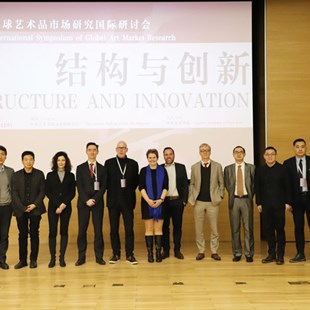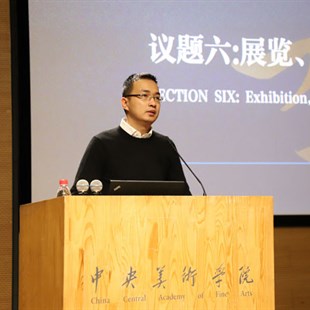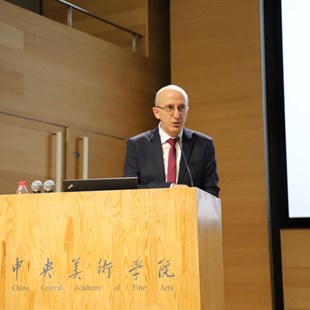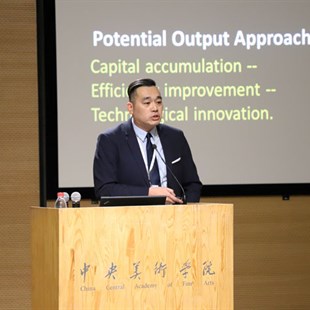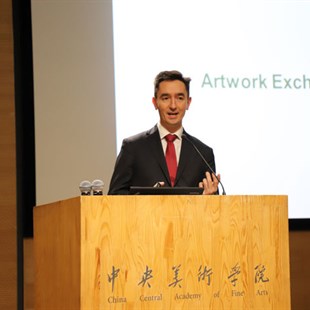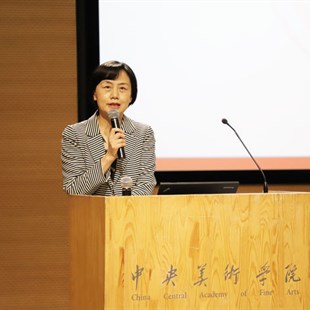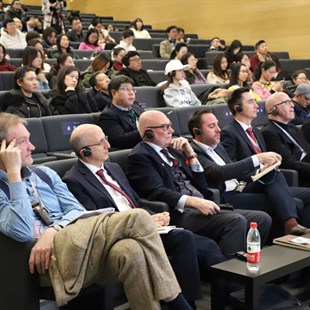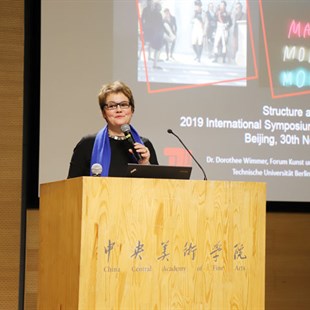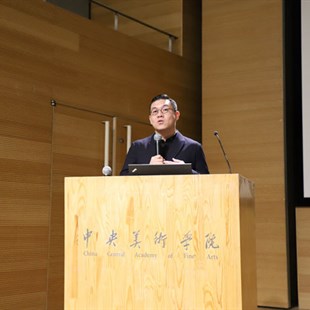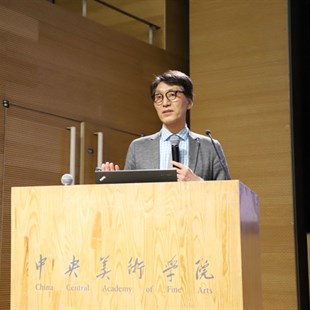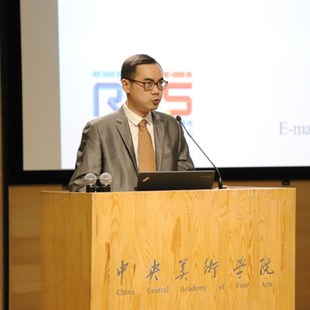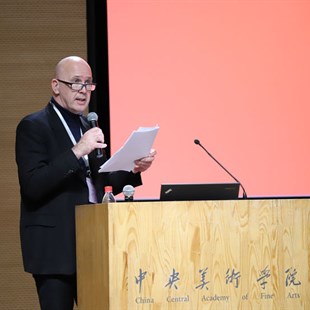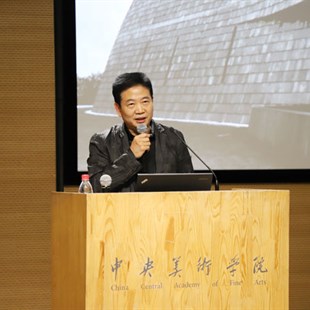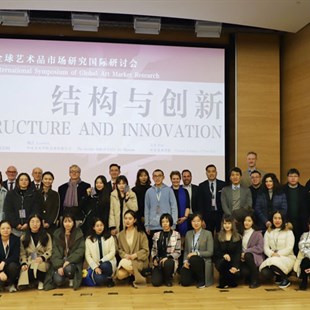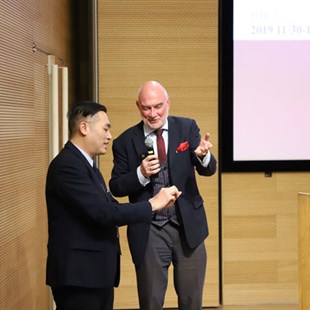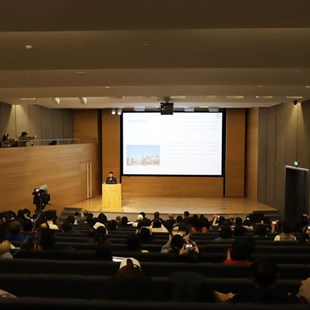From 30 November to 1 December, 2019, Structure and Innovation: 2019 International Symposium of Global Art Market Research was held at the Central Academy of Fine Arts. Twenty representative academic researchers from France, Germany, the United Kingdom, the Netherlands, Italy, Switzerland, Sweden, Poland, South Korea and other countries and regions attended the symposium. The theme of “Structure and Innovation” for the symposium was divided into ten sections to discuss the present hot topics in the Chinese and the global art markets. Each topic composed of speeches by a Chinese scholar and a foreign scholar. Based on similar research paths, this aimed at presenting multi-dimensional thinking from different angles at home and abroad, building communication mechanisms, and sharing highlighted dialogues.
After the first day’s topic speeches, the symposium on 1 December continued to focus on discussions on five topics, namely “Exhibition, Market and Contemporary Art”, “Financial, Wealth and Economic Analysis”, “Collection, Investment and Market Actors”, “Data, Index and Comparative Studies” and “Exhibition Curating, Galleries and Market Participation”.
[Genealogical Analysis] Exhibition, Market, and Contemporary Art
What kind of “commodity” attributes does art on the market have? How are artistic value and commercial value measured? Is the auction price of an artwork equal to its artistic value? Professor Jérôme Glicenstein from the Department of Plastic Arts, University Paris VIII, France, emphasized the importance of the aesthetic value and creative value of art in the context of the art market in his speech Art (Not) in the Art Market. “In today’s art market, traditional aesthetic value is no longer the only factor in judging the value of art. Art value is often influenced by sociological, psychological, economic and other factors. We need to look from outside the market to analyze the art that exists on the market rather than look at artworks in full accordance with the principle of ‘commodity’.”
By analyzing market data of classic artworks, Professor Jérôme Glicenstein raised this question: “People often think that the best works are the most expensive and this seems to be a common point of view on the market. The corresponding question is that if the work is not traded, does it mean it is not a good work?” The answer is no. Professor Jérôme Glicenstein made it clear that the value of artworks should not be measured solely by supply and demand and prices on the market. It is true that the best work is the most expensive, but the quality of an artwork cannot be completely equal to its economic value. Aesthetic value assessment should play an important role in it.
Professor Jérôme Glicenstein believes that art is the embodiment of human creativity, and that commercial value cannot fully reflect the aesthetic value of works. Therefore, it is necessary to condemn the consciousness of regarding art only as a commodity. In order to protect the special value of art, we should reduce its dependence on the market.
Therefore, Professor Jérôme Glicenstein put forward the idea of establishing “multiple values in the art market”: “Although non-profits and public institutions rarely participate in market behavior, we cannot deny their role and contribution in the formation of market values. In today’s art world, it is unrealistic to question the relationship between art and the art market. To a large extent, the value of artworks has been replaced by that of exhibits. But I still think that only if the balance between artistic value and commercial value can be achieved, the healthy development of the art market can be promoted. This is why we need to consider art on the market from a non-market perspective.”
Speaking of the global art market, China’s art market has made great achievements since reform and opening up. Although the Chinese art market started late, it has developed rapidly and new things have appeared frequently appeared, attracting worldwide attention. What efforts that the the Chinese art market has made have led to such comparative advantages? Professor Zhang Zhenglin from the School of Arts Administration and Education, CAFA explained the reasons why China has a comparative advantage in the world in his speech entitled Market, Event and Exhibition: Dialectical Links between Chinese Contemporary Art Market and Exhibition Technology (1990s to date). From the perspective of technological development, he used economic theoretical models as well as the developmental history of the Chinese art market in his speech.
In an in-depth analysis of the factors driving the rapid development of the Chinese art market, Professor Zhang Zhenglin used the “Leapfrogging Model” proposed in 1993 by three scholars including Paul Krugman, a Nobel laureate in Economics, E. Brezis and D. Tsiddon, as well as the “Late-developing Advantage Theory” put forward by Chinese economist Professor Lin Yifu to interpret the achievements of China’s art market: “Developing and developed countries have different advantages in global trade. At a certain stage in developed countries, the productivity of existing technologies tends to be higher than that of new technologies, so they often tend to continue to use the existing technologies; in developing countries, however, the cost of production factors such as labor is relatively low in a certain period, so new technologies can be selected from the beginning, thus gaining technological advantages in the new economic cycle. This is the reason why China’s art market, relying on institutional and technological innovations, can still catch up with or even surpass the level of world development in spite of its late initiation."
By enumerating Essentials of Economic System Reform in 1989, a new policy adopted by the State Council of China in 1989, the holding of the “Beijing International Auction in 1992”, the Notice on the Implementation of Public Auctions in the Handling of Public Property issued by the State Council, the establishment of Shanghai Duoyunxuan Auction Co., Ltd. and some other key events in the Chinese art market, Professor Zhang Zhenglin further proposed that the late developmental advantage of the Chinese art market is reflected in three aspects: the speed of capital accumulation, the improvement of efficiency and technological innovation. In addition, due to China’s large population, the vast consumer population has reduced the unit cost of transactions in China, which is conducive to the art industry to learn and transform Western models, and to quickly form a market structure with the capability of being international. Today, Chinese art institutions are still innovating. The globalization, clustering, integration of different industries, and the Internet have led to continuous technological and institutional reforms. There will be undoubtedly more growth points in the Chinese art market in the future. Such structural adjustment and innovation is also in line with the theme of this symposium: Structure and Innovation, which is thought-provoking.
[Financial Analysis] Financial, Wealth and Economic Analysis
If data is the necessary basis for analyzing the market, then capital, finance, and wealth are the most direct intervention factors and driving forces for the market. In his speech entitled Artwork Exchanges and Financial World, Professor Sylwester Andrzej Bialowas from the Department of Market Research and Service Management of Poznan University of Economics, Poland, analyzed the relationship between the art market and capital from two perspectives. The first part introduced the general situation of the art market through various key data. In the second part, the self-accounting RSR method in the Polish art market was compared with financial instruments, in which interesting market phenomenon like “monopoly effect” and “nostalgia effect” were found.
In analyzing the method of using statistical models to intervene in the analysis of art market data, Professor Bialowas said, “Although statistics can solve the problem of data output, in the later research, the measure we choose will directly affect the derived results. Specifically, what the base year of the data is will directly lead to different market forecast results derived from that data.”
At the end of his speech, by analyzing the auction data of the artist during his lifetime and after his death, Professor Bialowas pointed out the special phenomenon that the death of an artist will cause the prices of works to rise. For the following reasons, “One is that the number of works will not increase after the death of the artist, and the other is that people will miss the artist after reading media reports. The ‘death effect’ defeated the pricing method for Polish artworks, which shows that the data model cannot solve all problems.” Professor Bialowas hoped that more artists can actively participate in market research and that researchers would conduct long-term data collection to derive more objective and scientific research results.
From the perspective of macroeconomics, Professor Huang Yi, Deputy Dean of the School of Applied Economics, Deputy Director of the Institute of Art Finance, and a doctoral supervisor at Renmin University of China, conducted a structural analysis of the art market. In public cognition, the art market is often considered to be procyclical, and some collectors believe that the age can be a standard for measuring the value of art. In her speech Returns on Investment in Chinese Art: Structural Differences and Macro Features, Professor Huang Juan expounded the origin of her research and new thinking on such issues.
Taking the ancient Chinese painting and calligraphy market as an entry point, Professor Huang Juan deeply analyzed the great difference through data between art, as a “spiritual consumer product” and “alternative investment asset” and traditional financial products. Professor Huang Juan said: “2008 was not only an important node for the Chinese economy but also one for the art market economy. China has become a middle-income country since 2008, which means that people's consumption patterns have changed from survival consumption to enjoyment consumption. This is an important reason for the blooming of the art market.”
Looking back at the market data in recent years, it is not difficult to find that the art market is closely related to the macroeconomic environment and the income level of wealthy people. “In general, the cultural art market is procyclical, and we need to pay attention to the changing situation in the macro economy. Although the Chinese art market has made some progress, the investment income of art has no obvious advantage over stocks. The risk in investing art assets is often greater than that in traditional financial assets. Therefore, we need to treat them rationally when purchasing artworks, emphasizing their added value and bearing capacity as spiritual consumer goods. If we only seek returns from an investment perspective, we need to think twice.”
[Investment Analysis] Collection, Investment and Market Actors
Since entering the 21st century, the art market has seen prosperity, which can be seen from the trading volume of artworks, auction turnover, the number of high-net-worth individuals and the number of exhibition visitors. Professor Dorothee Wimmer, Director of the Art Market Research Center of the Technical University Berlin in Germany, gave a speech entitled Global Research Perspectives: Art Museums of the Past, Present and Future, Art History and Art Market, from the perspective of the art market behavior triggered by museums.
Professor Dorothee Wimmer first listed the new changes in the global art market in the new century: the number of private museums has exceeded that of public museums and more and more art collectors purchase artworks for investment and financing, which proves that the financial attribute and the quality of artworks have been constantly improving. Afterwards, Professor Wimmer focused on the art museum. Taking the French national art policies since The French Revolution as an example, Professor Wimmer introduced how state-led museums affect the establishment of the art value system. In the process of constructing the museum's collection and display systems, the value orientation of the art market has also been constantly rebuilt and updated with the historical trend.
Talking about the present, Professor Dorothee Wimmer said frankly, “In today’s world, the art market strategy is becoming more and more global, global buyers and consulting services for art and investment worldwide are becoming more and more popular and art intermediary agencies offer buying advice to worldwide customers in the art market. In terms of changes in customer groups and analysis tools, the art market has no longer simply taken museums’ collections as its guide, but gradually tilted towards the financial sector.” Based on these phenomena and trends, Professor Dorothee Wimmer put forward new expectations for traditional public museums in the new era. She hopes that public museums will incorporate new technological means, communication methods and research scope into their own construction and development, and consider the transformation model, so as to more actively guide the healthy art trends.
Professor Zhao Longkai, a Doctoral Supervisor at the Department of Finance of Guanghua School of Management, Peking University, viewed the inherent roots of the financialization of art from a more rational perspective. Professor Zhao explained and analyzed the realization of financial means in the art field from the three issues, including “what finance is, why art should be financialized, and whether art can be financialized.”
At the beginning of his speech, Professor Zhao Longkai shared the classic case of Bowie Bonds. Starting from this case, Professor Zhao Longkai put forward his unique insights on the nature of finance: “Some early forms of finance appeared when human transactions occurred in human history, even before the advent of art. The biggest role of finance is that it allows human beings to control future assets and money. It can be said that finance is a tool developed by mankind that can deal with the issue of time and finance is a time machine.” From primitive society to the present, the complexity and expansion of financial instruments stems from the more complicated definition of time. Professor Zhao Longkai believes that the purpose of finance is to help us rationally plan property in advance. Modern finance is a tool to help modern people deal with their relation with time.
Exploring the reasons for the financialization of artworks, Professor Zhao Longkai argued that it is not the artists that really need the financialization of artworks, but financial intermediaries. “Financial intermediaries do not create value by themselves and technological and market changes have caused them to change from relational to transactional roles, so they need to create transactions. At present, the most common transactional intermediaries rely mainly on bargaining power to make a profit. The value of this benefit comes from the information they have.”
At the end of his speech, Professor Zhao Longkai expressed his views on whether the art can be financialized. As a scholar with a financial background, Professor Zhao Longkai believes that with the help of financial intermediaries, the artistic characteristics of works are weakened, and the behavior of financial products is amplified. However, there is a special value evaluation standard for artworks, so the financialization based on the birth of modern industrialization cannot meet the needs of artworks’ financialization. Therefore, we should not apply the traditional financial method to the artwork finance. “Perhaps the business practices surrounding art should always be based on interest and aesthetic taste in art.”
[Comparative Analysis] Data, Index and Comparative Research
As the most direct way to study the art market, the interpretation of data is the analytical method used by almost every speaker in their speeches. However, what kind of inspiration the information behind the data brings to the researchers depends largely on the position of the researchers themselves. In his speech entitled Economic Fluctuations and Structural Changes in the Asian Art Market, Professor So Jinsu, Director of Economics Department and President of the Art Market Research Institute (AMR) of Gangnam University in South Korea, made a reasonable inference and research on the market data based on the development and future of the Asian art market.
Through analogy of related data, Professor So Jinsu proposed that the prosperity of the art market depends largely on the economic situation. In recent years, the world economy and the global art market have fluctuated, followed by changes in the structure of the art market. As the global art market continues to grow, art will increasingly highlight its value at the financial level. And in 2019, the global art market has once again been affected by the global economic slowdown. At the microeconomic level, people often hear unexpectedly high prices on the market, but at the macroeconomic stage, the overall development of the global art market is slow and weak. Professor So Jinsu believes that this is due to the cyclical law of the art market. 15 to 17 years are often taken as a cycle though the cycle interval is getting shorter and shorter.
With the change of the center of gravity of the global art market, the Asian art market represented by China has occupied an important position and is showing an increasingly active trend, especially in the field of contemporary art. At the end of his speech, Professor So Jinsu concluded: “I think the three most important keywords of contemporary art are fun, importance, and capital. We can see that these three elements have all appeared in the Asian market. In the unified Asian market, more detailed regional markets will be differentiated in the future. With changes in macroeconomics, the Asian market will see a structural change.”
With the continuous innovation and development of the global art market, there are more and more quantitative studies on the art market index. But can the data involved in these indexes reflect the true situation of the art market? Ma Jian, associate professor of the College of History and Culture of Southwest University for Nationalities and executive director of the Southwest Research Center of the National Cultural Industry Innovation and Development Research Base, questioned the reference value of market data in his speech Will the Art Market Data Lie? Professor Ma analyzed the reasons for his suspicion of the data authenticity from seven perspectives: the particularity of artworks, discrepant scopes, inherently biased samples, carefully selected data, undisclosed information, manipulability variables and signals that are easily distorted, and finally gave his own conclusions and suggestions.
Professor Ma Jian believes that a large part of the market data currently open to the public is the result of screening or an incomplete collection. In the process of operating the market, dissemination and publicity have greatly affected the public’s judgment on data and the market, which has directly led to data changes and choices. “From the perspective of market sales, whether art can be sold at high prices is highly affected by the marketing level of intermediaries, brokers, and auction companies. This in itself leads to deviations between the data and the true value of the art. In addition, in information dissemination, much undisclosed information, such as black market data and genre data, largely represent the other side of the market. The art index is like a double-edged sword that can be easily manipulated by stakeholders.”
Regarding how to pursue the authenticity of the data as much as possible, Professor Ma Jian believes that the industry should establish a correct view of the art market data: “Industry associations should establish a secondary release mechanism for art data. The data released by the media is for the pursuit of news and timeliness, while industry associations should do a good job of correcting the data later. They should correct and reconfirm the relevant data after fully collecting the relevant information to avoid the lack of subsequent maintenance of the data.”
[Institutional Analysis] Exhibition Curating, Art Museums and Market Participation
What effect does the curatorial system of art institutions represented by art museums have on the art market? In his speech entitled Contemporary Art in Institutions and Markets, Jonas Stampe, senior curator and senior researcher of the Red Brick Art Museum, discussed the relationship between the art market and the art system from the perspective of the curator. Jonas Stampe first shared the British artist group K Foundation’s work Burn a Million Quid to supplement how artists use their own methods to express their attitudes towards money through artistic creation. In the current market situation, what kind of public thinking will be caused by the rebellion against money and destruction? Jonas Stampe said in his speech, “Needless to say, this work is full of power, but this work was not created for the market. On the contrary, it is a challenge to money and market rules.” This is not the impact of surface images, sounds, colors or technology, but a deeper alertness and reflection brought by art.
Afterwards, Jonas Stampe shared the operating method of the Free Art Port of Geneva. “There are more than 80 tax-exempt art warehouses in Europe. According to tax and market surveys, works in tax-exempt institutions have an unreported hidden value of one billion US dollars. The relationship between these works and the works in the museum's collection system is a topic worthy of discussion.”
At the end of his speech, Jonas Stampe used different data and rankings published by various institutions to interpret the appeal and efforts of art institutions for market influence. “The data owned by each institution will reflect its position and importance in the entire market system. Institutions use data to measure the influence of artists associated with it.” As an art institution operator, Jonas Stampe proposed that art institutions should appropriately provide works for and intervene in the art market, and guide the public thinking on issues such as art and prices, market and mechanism, information and standards, playing the role of “leader” in the art ecosystem.
Zhang Zikang, Director of the CAFA Art Museum, analyzed the art industry from the perspective of the art museum. By analyzing the art museum’s mission in history and the changes in the role of them during the rise of the art market, Director Zhang proposed that the art museum is a non-profit organization in the art industry, which affects the entire cultural industry and urban development and the embodiment of cultural deposits. “Art has been assigned a destiny since the day it was born. On the one hand, a mechanism or an intermediary is needed so that people with taste can have the opportunity to own it; on the other hand, the market is needed to repay artists for their time, money and material costs. The market economic value of art needs to be realized through the distribution of the industrial chain, among which is the contribution of art museums to the criteria of art value evaluation.”
Director Zhang pointed out in his speech that the CAFA Art Museum is also facing challenges whether it is the choice of commercial business model or academic research. The CAFA Art Museum hopes to work hard to let people recognize how artists create outstanding artworks. Society should be guided to recognize the true intrinsic value of artworks, thereby leading to the healthy development of the art market. “In the context of today’s business, industry and economic megatrends, it is particularly important for art museums to maintain their own judgment and standards and continue to improve their independent academic systems. This is also a question we should actively think about.”
After two-days of wonderful exchanges, Structure and Innovation: 2019 International Symposium of Global Art Market Research came to a close on the afternoon of 1 December. Through the discussion on the ten topics, including “Laws, Regulations, and Market Formation”, “Assets, Value, and Evaluation System”, “History, Aesthetic Consumption and Market Transactions”, “Technology Innovation, Cross-Industry Integration and Industrial Ecology”, “Global, Regional and Structural Changes”, “Exhibition, Market, and Contemporary Art”, “Finance, Wealth and Economic Analysis”, “Collection, Investment and Market Actors”, “Data, Index and Comparative Studies”, “Exhibition Curating, Art Museums and Market Participation”, scholars and experts from all over the world, combining their own practical experience, shared their cutting-edge research, actively discussed the development and pattern of the art market brought by technological and operational changes and provided practical guidance for the cultivation of professionals in the art market in the future. The symposium achieved fruitful academic results.
At the closing ceremony, Professor Zhang Zhenglin called on the international experts, scholars and industry colleagues present to take this symposium as an opportunity, to continue to promote the academic plan for business of art and the art market, sort out the industry context, and work with many personnel in art. This is aimed at the publication of a related book on the global art market research next year, presenting a general understanding of the art market field realized by the industry and academia, so as to establish a close connection between China and the international art market in the professional field. The Central Academy of Fine Arts hopes to strengthen the integration of academic research and practical fields by promoting the cross-regional art market research cooperation mechanism, so as to provide a relevant academic guarantee for the healthy development of the Chinese art market and contribute to the sustainable and healthy development of the global art market.
Courtesy of School of Arts Administration and Education at CAFA, edited by Sue/CAFA ART INFO



